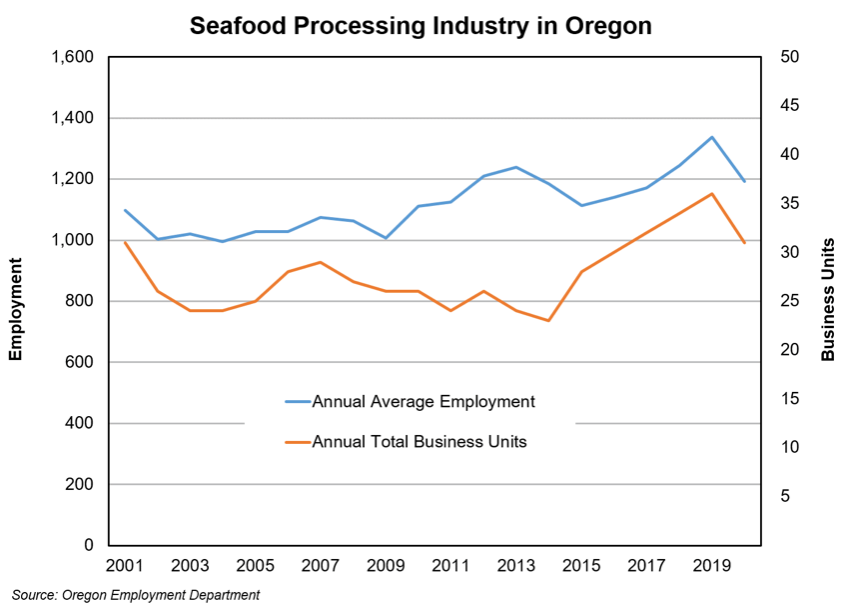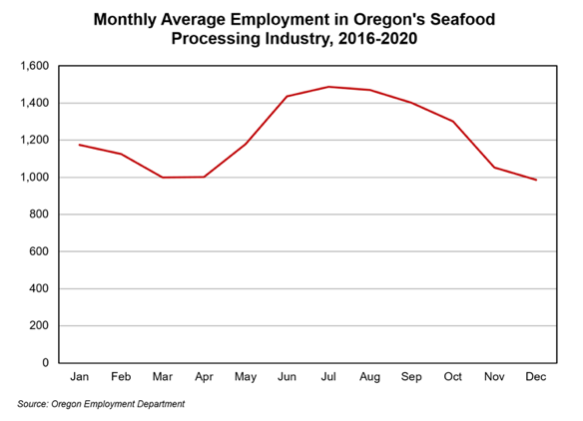In Cod (And Crab!) We Trust – Oregon’s Seafood Processing Industry
By Erik Knoder Oregon Regional Economist Clatsop, Columbia, Lincoln, and Tillamook counties erik.a.knoder@oregon.gov Originally posted at https://www.qualityinfo.org/-/in-cod-and-crab-we-trust-oregon-s-seafood-processing-industry

In 2020, Oregon had 31 employers and 1,192 employees turning slimy fish and armored crustaceans into succulent seafood ready for cooking and eating. These numbers are down from previous years as the industry was hit by the pandemic recession.
Commercial fishers landed about 345 million pounds of fish and shellfish in Oregon in 2020, about 81 pounds per Oregonian. About 64% of this volume consisted of whiting, mostly used to make surimi. Total harvests had a dockside value of $152 million, a decrease of 6% from the year before. Fishermen sold a small portion of the harvest off their vessels or at markets directly to consumers. Most, however, was sold to processors and buyers then exported or sold to wholesalers, retailers, restaurants and consumers.
The seafood processing industry – part of the manufacturing sector – includes businesses that clean, freeze, can, smoke, salt, and dry seafood. It also includes firms that shuck and pack shellfish. Although Oregon currently doesn’t have any, it also would include processor ships that do these operations at sea. Except for certain fishermen licensed to sell fresh fish from their boats, the Oregon Department of Fish and Wildlife requires commercial fishers to sell their harvest to licensed wholesale fish dealers or licensed fish buyers. Many of these dealers and buyers are also processors.
Oregon exported roughly $57.1 million worth of fish, crustaceans, other marine products, and related prepared products in 2020, according to the U.S. Census Bureau. Canada was by far the leading foreign destination, taking one-third of all exports. Japan, China, and Europe were other major destinations. About one-third of seafood exports are as whole frozen fish, presumably with further processing done in the destination country.
The number of seafood processing businesses had been slowly declining since 2007, but that trend reversed in 2015. Oregon’s processing industry gained five businesses that year. Since then Oregon has added two businesses each year until 2020. Oregon lost five businesses in 2020. It’s hard to tell if the future trend will be expansion or more consolidation. Consolidation has occurred in the Oregon fishing fleet. Three counties, Lincoln, Clatsop, and Coos, had about 81% of all commercial fish landings by value in Oregon in 2020. Smaller ports like Garibaldi, Depoe Bay, and Florence struggle to find money for infrastructure, dredging, and jetty maintenance that can attract vessel owners and seafood processors.
Employment Trends in Seafood Processing

The seafood processing industry fared relatively well during the Great Recession, but it took a pretty good hit during the COVID-19 pandemic. Some processors laid off staff and had temporary closures. Employment fell by 11% on an annual average basis in 2020. Employment dropped from 1,338 in 2019 to 1,192 in 2020. A few processors also closed locations. The number of business units fell by five to 31 in 2020.
Employment in seafood processing tends to be fairly seasonal. It peaks in midsummer and hits its low point in March. Much of the industry’s employment depends directly on when fish are landed. This in turn depends on weather, ocean conditions, fish life cycles, and regulations, especially those established by the Pacific Fishery Management Council. This council has the authority to open and close many fisheries important to Oregon.
The summer employment peak coincides not only with better fishing weather, but increased availability of fish. Tuna, salmon, and especially Pacific whiting, are all available in the summer. Pacific whiting, also called hake, is typically Oregon’s largest fishery by volume. More than 219 million pounds were landed in 2020. (On the other hand, because it was plentiful it fetched only seven cents per pound when landed.) Whiting is used to make surimi, which in turn is used to make imitation “crab” or “lobster” meat. Manufacturing surimi requires a good deal of very controlled processing and rapid cleaning and handling of the fish. This means that surimi processors must hire many seasonal employees.
Another, smaller, peak in seafood processing employment typically occurs in December and January. Although the weather is often dangerously bad at this time, December is traditionally the beginning of the Dungeness crab harvest. Crab is often Oregon’s most valuable single fishery. Nearly 20 million pounds were landed in 2020 with a value of $72.8 million. In contrast to inexpensive whiting, Dungeness crab fetched about $3.66 per pound. The crab harvest is a derby fishery; it’s first come, first served as boats and crews race to scoop up as much as they can before someone else does. The result is a glut of crab landing on processors’ docks that must be cleaned, cooked, picked, and frozen in short order. Seasonal employees allow processors to get through the short-lived crab bonanza.
The skill requirements are modest for many seafood processing jobs. Line jobs are generally entry level. Applicants often must pass a drug screening test and a criminal background check. The work is often 12-hour shifts, seven days per week during the busy seasons. The demand for workers in tight labor and housing markets recently led one Astoria processor to purchase an apartment complex to help provide housing for its workers. Overtime is a part of the job and the base pay is usually minimum wage. Other jobs, such as truck drivers and quality inspectors, require more skill and pay more.

Other Processors
Oregon has a number of businesses that handle and process seafood aside from the major processors. If seafood processing is a sideline for a business, it may be counted in another industry because businesses are categorized according to their main operation. There are a handful of oyster farms along the coast that shuck and package oysters, although their main business is farming the oysters. Oregon Oyster Farms in Newport and Clausen Oysters in North Bend grow oysters and ship them worldwide.
Other firms that distribute seafood or sell wholesale or retail may also do some processing. The Garibaldi Cannery on Tillamook Bay is one such multi-purpose firm. The company does processing, buying, and retail and helps keep the port at Garibaldi an active fishing port. Small firms are more common for salmon and albacore tuna. The websites for the Oregon Albacore Commission and the Oregon Salmon Commission each list several dozen firms that handle these seafood products and provide canned, frozen, and fresh fish.
Out-of-State Opportunities
Some seafood processors recruit Oregonians to work in out-of-state plants, primarily in Alaska during the summer months. Companies such as Trident Seafoods, Signature Seafoods, and Ocean Beauty routinely recruit employees for their Alaska operations. Although the jobs may be listed in Oregon, out-of-state jobs don’t count as official Oregon employment and are not included in this analysis.
The Alaska processing work is similar to that in Oregon: few skill or experience requirements, working on a processing line, 12- to 16-hour days, seven days per week. The difference is the geographic isolation. Many Alaska facilities are in remote locations and employees live in dormitory style housing in company towns.


Advertisement